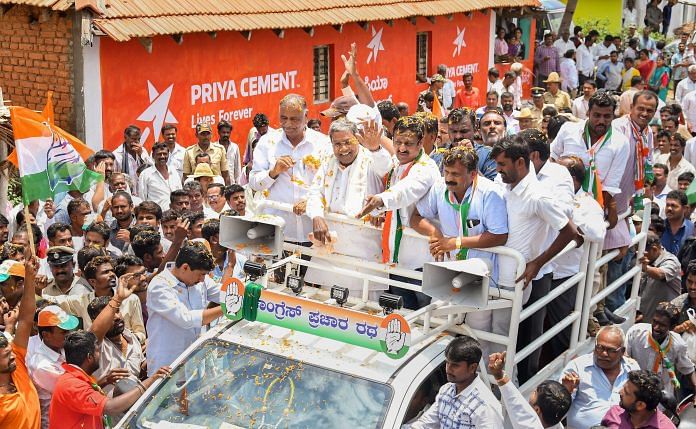From Siddaramaiah’s sub-nationalism to BJP’s Hindutva gambit, these five factors will decide whether Congress will retain its biggest state or BJP will return to power in the south.
New Delhi: It’s over to about five crore voters in Karnataka now. As they exercise their franchise Saturday, they will not only decide who is better equipped and suited to govern their state, but will also set the stage for a larger political battle at the national level.
BJP president Amit Shah sees the Karnataka election as the party’s “gateway to the south”, while the Congress and other opposition parties hope to see in the results a reassurance of their existence and relevance, and an indication of the saffron party’s waning appeal, if at all. The poll outcome in Karnataka is likely to set the stage for the semi-finals in Rajasthan, Madhya Pradesh and Chhattisgarh in November, before the final battle for the coveted Lok Sabha crown next year.
So, with so much at stake for the ruling and opposition parties, what will determine the winner in the electoral sweepstake in Karnataka? There are broadly five factors that are likely to separate the winners from the losers:
AHINDA
It’s a Kannada acronym for minorities, backward castes and Dalits. In a state where Lingayats and Vokkaligas (who together roughly constitute around 30 per cent of the population) wield the levers of power, Siddaramaiah, an OBC leader, has sought to create an alternative political bloc through the consolidation of the AHINDA vote bank. He has splurged freebies and launched a host of welfare schemes for AHINDA. Reports from the ground suggest that these measures have worked favourably for the chief minister, but the jury is out on the extent of consolidation of these diverse groups.
Corruption
The poll campaign was marked by allegations and counter-allegations, with the Congress and the BJP painting each other as more tainted. The Congress targeted the BJP’s chief ministerial candidate, B.S. Yeddyurappa, who had to resign as chief minister in 2011 following his indictment by the Karnataka Lokayukta in a report on alleged illegal mining. He was acquitted by a court later, but the Congress remained unrelenting in its attack on him, especially as the BJP gave tickets to two brothers and associates of the controversial mining baron from Ballari, Gali Janardhan Reddy, who is on bail in the mining scam case.
Prime Minister Narendra Modi led the BJP’s counter-attack, terming the Siddaramaiah government as “a 10 per cent commission government” and “corruption tank” of the Congress, with pipelines linked to Delhi. He cited scams during the UPA regime at the Centre and attacked Sonia and Rahul Gandhi, who are on bail in the National Herald case. Voters will deliver their verdict Saturday on which of the two they consider more tainted.
Hindutva
The BJP sought to craft a Hindutva narrative to counter Siddaramaiah’s attempted social engineering. The message was clear from the beginning of the campaign as BJP president Amit Shah made well-publicised visits to temples and mutts.
The saffron party raked up the killing of 23 BJP/RSS/Hindu activists during the Congress regime, and blamed “jihadists” belonging to Muslim organisations such as the Popular Front of India (PFI).
The state government’s decision last year to celebrate the birth anniversary of Tipu Sultan, the 18th century ruler of Mysore, figured prominently in Prime Minister Narendra Modi’s and other BJP leaders’ election speeches. Modi also praised Mangaluru-based artist Karan Acharya for his “angry Hanuman” portrait, and accused the Congress of creating a controversy over it. Similar words and actions, allegedly aimed at bolstering Hindutva narrative, marked the BJP’s poll campaign. Party insiders believe that Hindutva will be one of the major determinants in this election.
Lingayat gambit
With the BJP projecting Yeddyurappa, a Lingayat, as its chief ministerial candidate, Siddaramaiah sought to counter it by recommending ‘separate religion’ status to the community, which constitutes about 17 per cent of the population, and has a decisive say in 100 out of 224 assembly constituencies. After the unceremonious removal of Veerendra Patil, a Lingayat chief minister, by then-Congress president Rajiv Gandhi in 1990, the community got alienated from the grand old party. Siddaramaiah’s move was aimed at wooing and splitting the BJP’s core vote bank, but even Congress leaders concede that the gambit may not produce the desired results.
Nationalism versus sub-nationalism
Months before the elections, Siddaramaiah started playing the Kannada pride card, as he unveiled a separate flag of Karnataka, and made Kannada compulsory in schools. He referred to seventh century Chalukya king Pulakeshi’s defeat of “northern king” Harshavardhan, seeking to project the assembly election as a contest between him and Modi.
The Prime Minister hit back, accusing the Congress of disrespecting the armed forces by questioning proof of the surgical strikes on terror camps across Pakistan-occupied Kashmir. He accused Jawaharlal Nehru of insulting two Army chiefs, Field Marshal K.M. Cariappa and General K.S. Thimayya, who belonged to Karnataka.
Nationalism versus sub-nationalism and identity politics dominated the poll discourse in Karnataka, but how much impact they would have on voting day is anybody’s guess.






